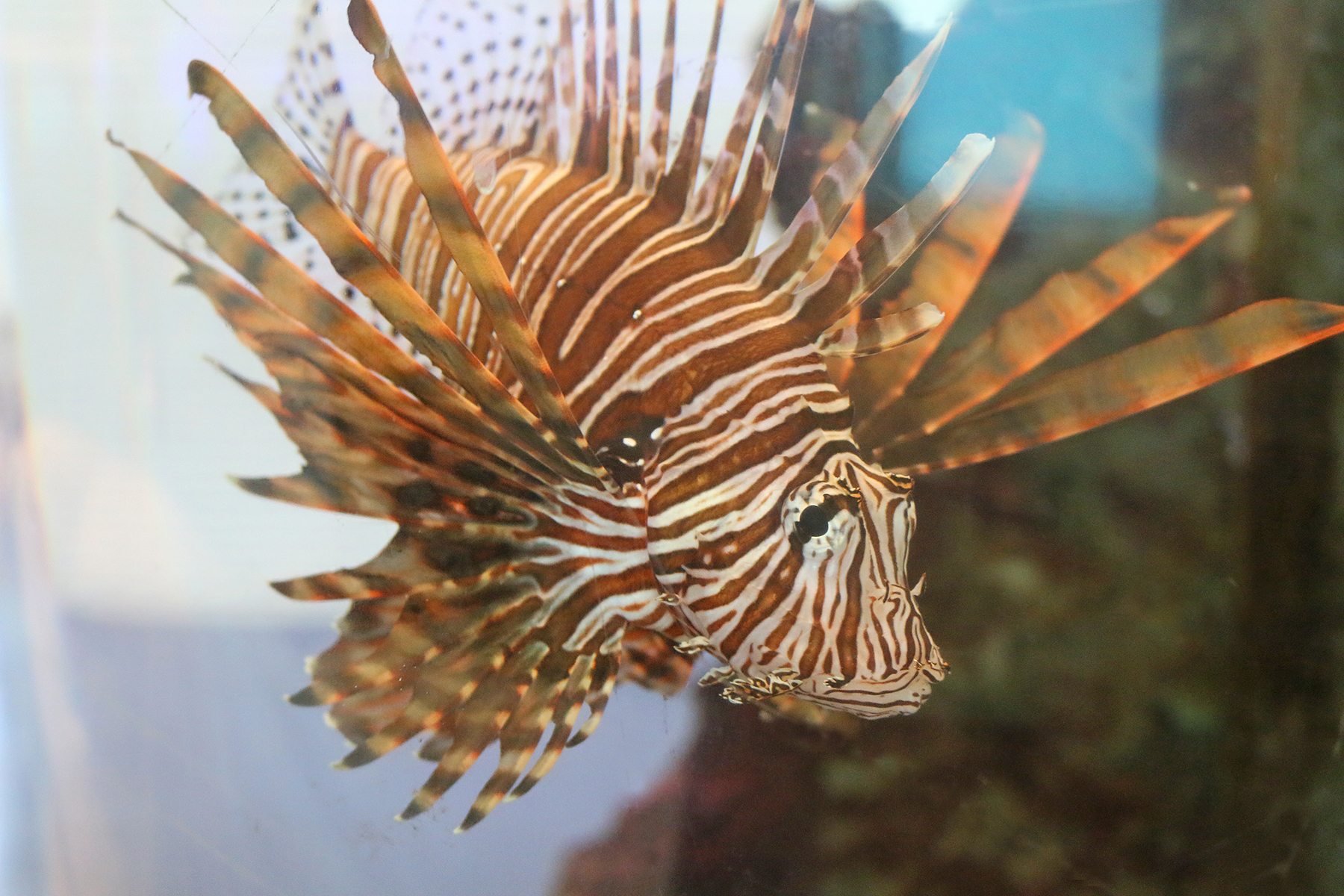
Before you eat your Thanksgiving turkey, come to The Maritime Aquarium at Norwalk Nov. 14 & 15 and sample turkey fish.
“Turkey fish” is another name for lionfish, an invasive species in the spotlight during the Aquarium’s “Turkey Fish Weekend.” Lionfish are nicknamed “turkey fish” because their splay of fins and venomous spines resembles a male turkey in full display.
During “Turkey Fish Weekend,” The Maritime Aquarium will support a federal “Eat Lionfish” campaign. (Only the spines of lionfish contain venom, and they are removed during filleting.) While supplies last, the Aquarium’s onsite caterer, Philip Stone Caterers, will serve up free samples of turkey-fish ceviche. (See recipe.)
Plus, at a special station, Aquarium guests can safely touch real lionfish spines while learning about lionfish and the issues that lionfish cause on the Atlantic coast. Activities will extend to other invasive species as well, explaining why invasive animals and plants are such a threat to our native species.
Guests also can make a turkey-fish craft, be a turkey fish in a fun photo opp, and of course visit live turkey fish in lionfish exhibits near the Aquarium’s Gift Shop and Shark & Ray Touch Pool.
Lionfish (Pterois volitans) are native to the Indian and western Pacific oceans, but divers – presumably, some very surprised divers – first encountered them off Florida’s Atlantic coast
in 1985. How’d they get there? Well, because lionfish have such a cool unique appearance, they’ve been popular with people who keep saltwater aquariums. Scientists suspect that a few of these folks in Florida released their “pets” into the Atlantic. (The first known instance of lionfish escaping into the Atlantic is said to have occurred in Biscayne Bay, Fla., in 1992 when Hurricane Andrew destroyed a beachside house and the home aquarium inside.)
However it was that lionfish got into Florida’s waters, the fish found conditions cozily similar to their home habitat, and so they settled in and started snacking on the native fish and making more lionfish. Since then, lionfish have spread throughout the Bahamas, Caribbean and the Gulf of Mexico, and also north – now as far as Rhode Island and the south shore of Long Island.
Larger fish species on our coastline – the apex predators like sharks and grouper – aren’t wired to recognize lionfish as food, so the lionfish population has been able to grow unchecked.
“Perhaps the only thing that has kept lionfish out of Long Island Sound so far is that Long Island acts as a barrier, with only two entrances into the Sound at each end,” said John Lenzycki, the Aquarium’s curator of animals. “But it might just be a matter of time before we see juvenile lionfish here in the summer.”
It’s troubling enough, having a venomous predator-less fish marching up the Atlantic. Even more troubling is their harmful impact on the environment. Lionfish are voracious eaters, so they can quickly reduce the fish population on a reef. Some of the fish they eat serve a purpose on the reef – like parrotfish and triggerfish, which eat algae and keep it from overgrowing the coral. If the lionfish reduce the parrotfish and triggerfish populations, the coral may struggle and then the whole reef has an issue.
Perhaps the best hope in stopping lionfish lies with the creatures that by far consume the most seafood: us! In 2010, the National Oceanic & Atmospheric Administration (NOAA) kicked off a “Eat Lionfish” campaign. It turns out, when properly and safely filleted, lionfish is – according to NOAA – a “delicious, delicately flavored fish.” It’s said to be great fried, grilled or used in ceviche. Eating lionfish has two benefits: helping to control the lionfish population, while providing a seafood alternative to such overfished species as snapper and grouper.
“Right now, unless you live in Florida or the Caribbean, you probably won’t see lionfish in your local fish market,” Lenzycki said. “But we might eventually if the demand increases. This is one rare instance where overfishing a species off our coast would be beneficial.”
All the activities on “Turkey Fish Weekend” are free with Aquarium admission.
Learn more about Maritime Aquarium special events, programs, exhibits and IMAX® movies at www.maritimeaquarium.org.
The Maritime Aquarium is a not-for-profit organization whose mission is to educate visitors about – and to create stewards for – Long Island Sound. It accomplishes this by allowing visitors to get close to more than 250 species native to the Sound and its watershed, including sharks, seals, sea turtles, river otters, jellyfish and other animals. One of the top places for family fun in Connecticut, the Aquarium also features hands-on educational programs and displays, public study cruises out onto the Sound, and Connecticut's largest IMAX movie theater, with a screen that's six stories high. TripAdvisor.com reviewers rate The Maritime Aquarium as one of the Top 25 aquariums in the U.S. and the best aquarium in New England.